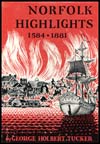Chapter 25
Norfolk Theater History - Part I
Norfolk's recorded theatrical history dates from November 17, 1751, when a company of strolling actors headed by Walter Murray and Thomas Kean presented "The Recruiting Officer," a comedy by the Irish playwright, George Farquhar, in "Capt. Newton's Great Room."
From then until the Revolution, Norfolk, as Virginia's most important port, had a fairly active theatrical history.
Norfolk's first regular theater, however, was "a wooden structure that had originally been built as a pottery."
According to the reminiscences of an octogenarian published in the Norfolk Herald of June 19, 1839, this pottery, refurbished as a playhouse, "stood on the rear of a lot on the south side of Main Street, somewhere about King's Lane on the river margin."
It was in this building that the theatrical troupes that visited pre-Revolutionary Norfolk put on their performances, and it was also within its walls that a serious riot took place when the reminiscing octogenarian was a boy. This is how the Herald reported it:
"Norfolk in those days was pretty much of a John Bull sort of town, and a theatre row could be got up as summarily here as within the walls of the Old Drury or the Haymarket. One night when the tragedy of Theodosius, or the Force of Love, was to be played, our friend paid his half crown for a children's ticket and squeezed in amongst the crowd that filled the house to overflowing. The hour for the curtain to rise had passed and the audience began to testify their impatience in the usual way of stamping, thumping with sticks and umbrellas, whistling, etc., to which no response was made by the prompter's bell. A half hour passed beyond the time, and still there was no shew of beginning. Presently a nose and one eye, reconnoitering the audience through a hole in the green curtain, caught the attention of Lawyer Curle, who flung a bottle at the two inquisitive organs with such remarkable precision that their owner received the missive full in the forehead, and honored (it) by immediate prostration. This was a signal for a general row: the stage was invaded in a twinkling, the curtain torn down, and the scenery, including the sacred altar prepared for the first scene, shared the same fate."
Incidentally, the "Lawyer Curle" who was such a good marksman with a bottle was William Roscoe Wilson Curle, a member of a prominent Elizabeth City County family and a secretary of the Norfolk Sons of Liberty when that group was organized on March 31, 1766, to protest the Stamp Act.
Almost on the eve of the Revolution, the old King's Lane playhouse was used for another purpose, a meeting place for the Methodists of the borough.
According to Bennett's "Memorials of the Methodists in Virginia," when the Reverend Francis Asbury, the Anglo-American preacher and first bishop of the Methodist Episcopal Church in the United States, came to Norfolk in 1775, he found the persons of his sect meeting in an "old, shattered building which had formerly been a playhouse."
Here, according to the same source, the Reverend Mr. Asbury preached for the first time in Norfolk, to a congregation of one hundred and fifty persons.
A few months later, Norfolk's first Temple of the Muses went up in flames when Lord Dunmore, the last royal governor of Virginia, and the Virginia forces burned pre-Revolutinary Norfolk to the ground.
Chapter
26
Norfolk Theater History - Part II
Norfolk Highlights 1584 - 1881

See the "Table of Contents" for links to every chapter in Norfolk Highlights 1584 - 1881 by George Holbert Tucker.
